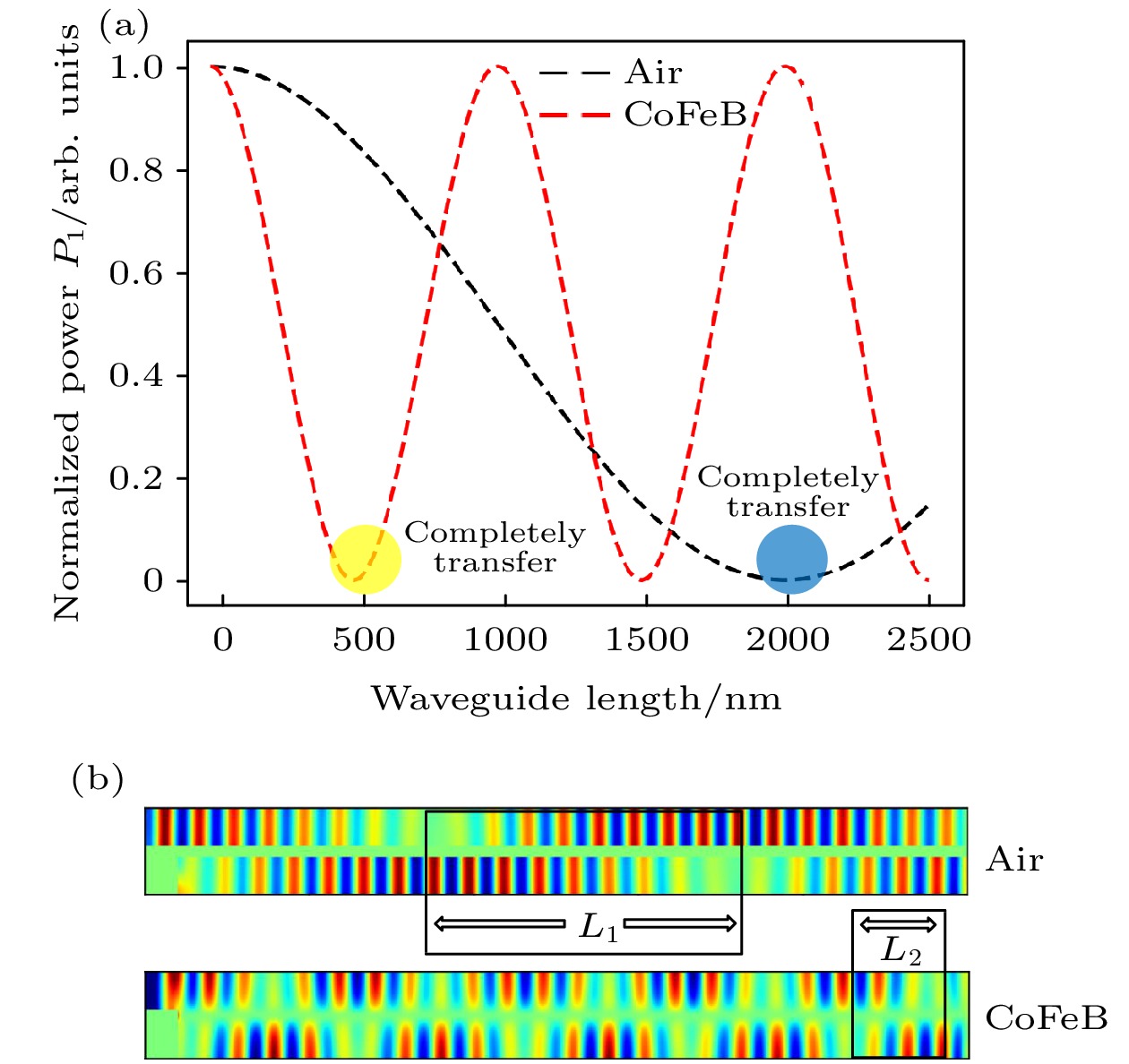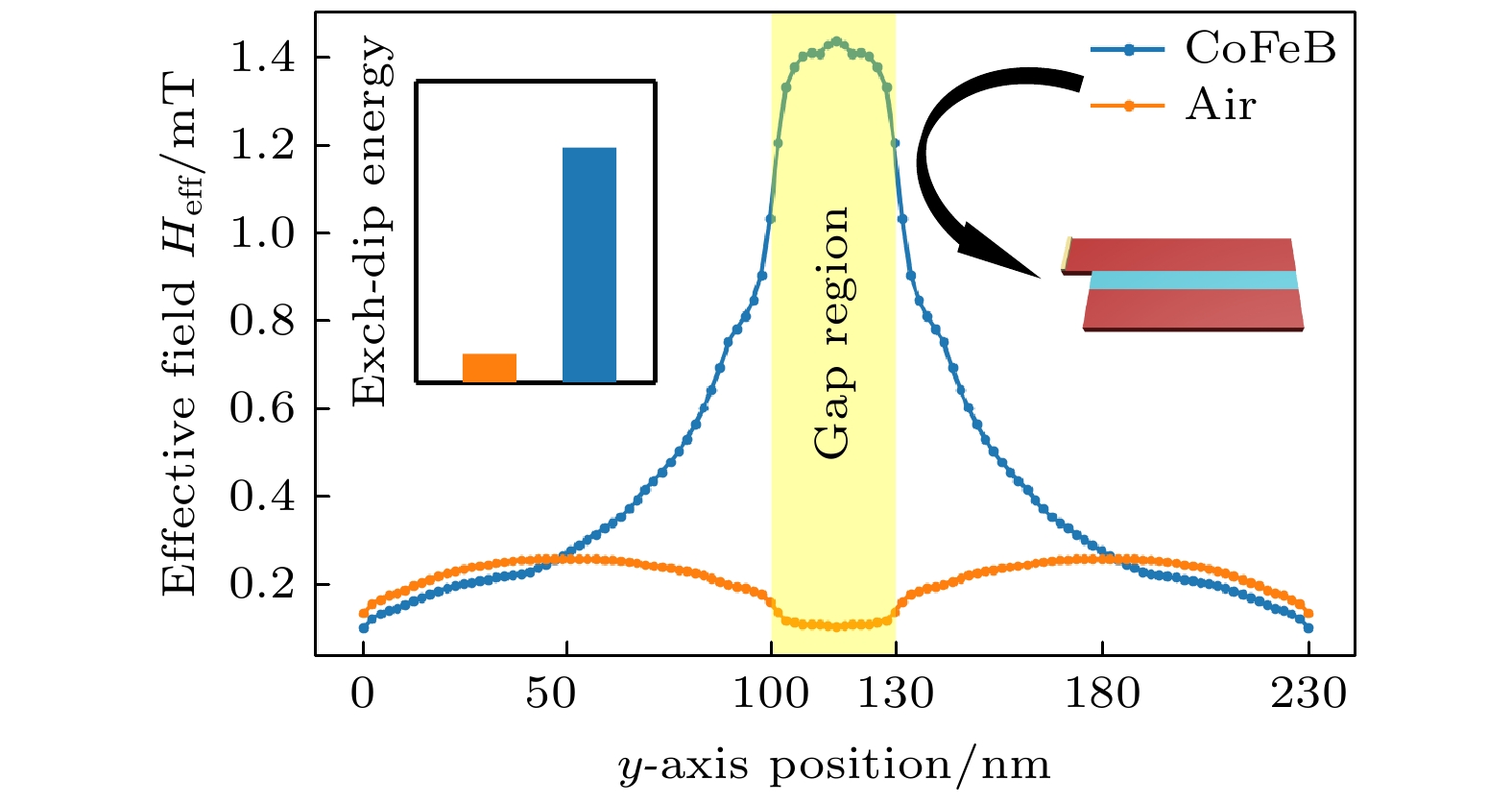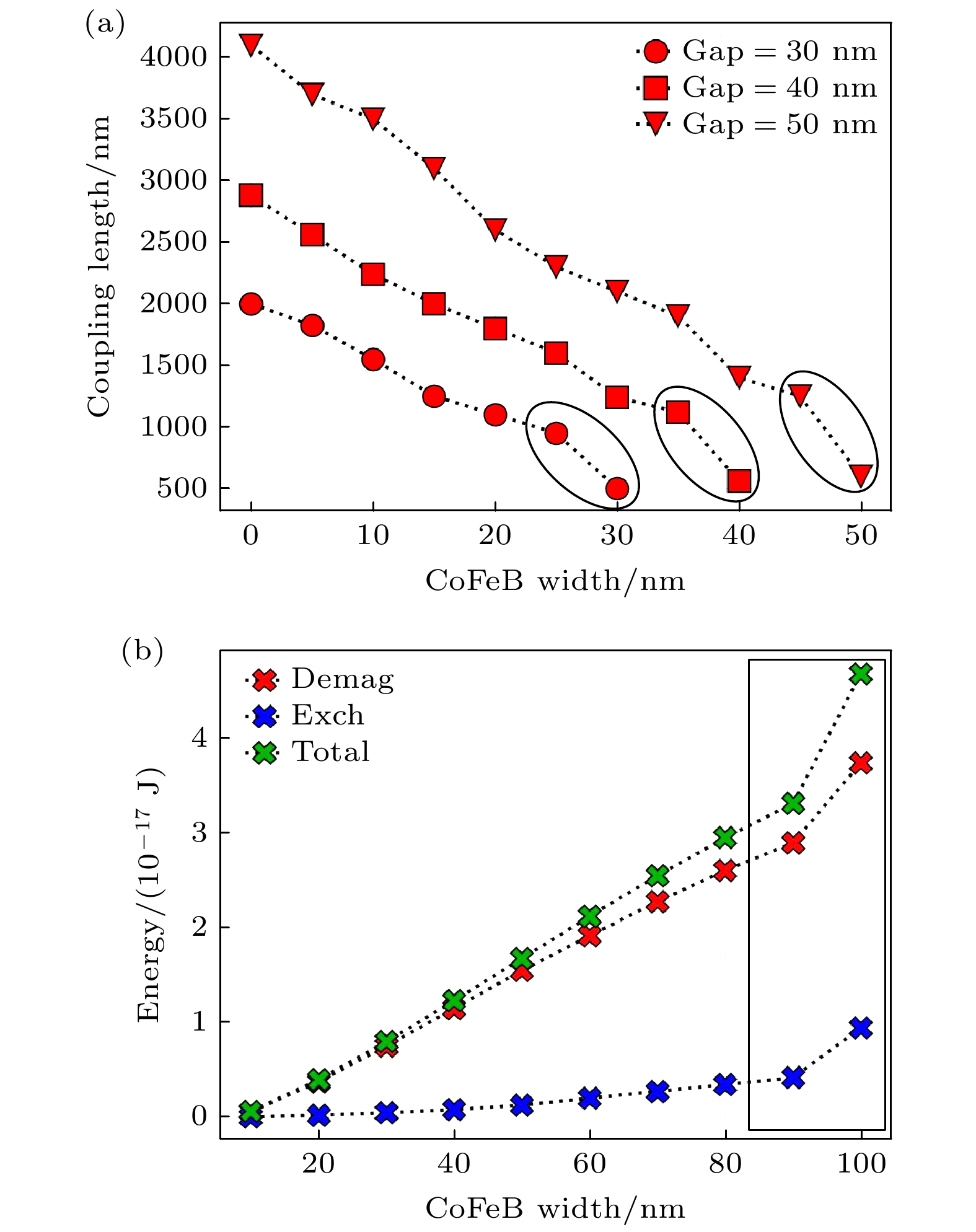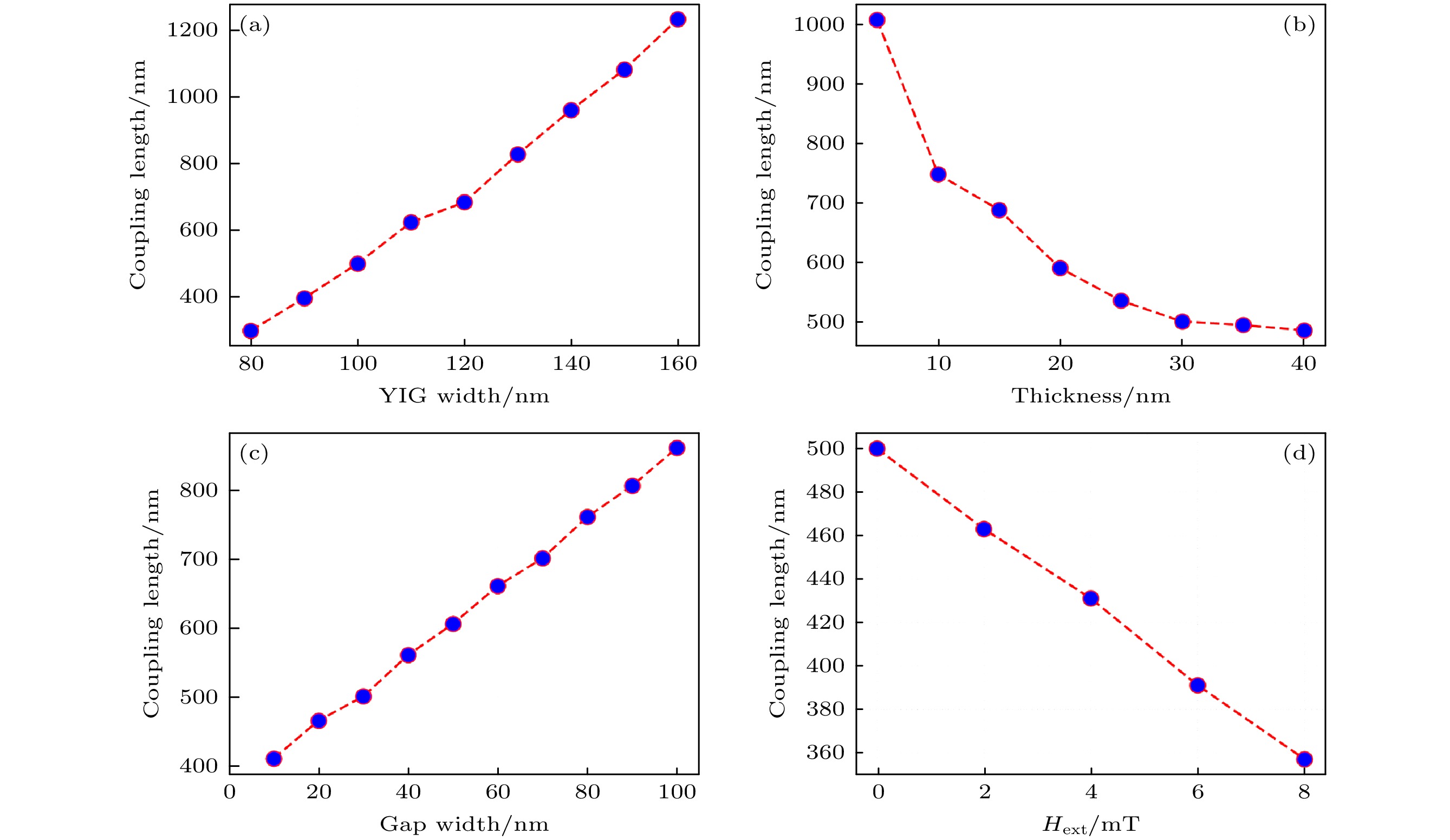-
The spin-wave coupling device is used as a connection unit to solve the connection problem between spin-wave devices. However, the current size is too large in comparison with the nano-scale process, which is caused by the low efficiency of the spin wave within it. Therefore, we propose the spin-wave directional coupler based on Y3Fe5O12-CoFeB coupling which can improve the current dilemma to a certain extent. By filling the gap layer of two spin-wave waveguides (Y3Fe5O12) placed in parallel with CoFeB material, it is found that the dispersion relationship of the spin wave changes in the data calculation of the micromagnetic simulation software Mumax3. The existence of CoFeB makes the transmission efficiency of the spin wave between the two waveguides higher than in the case without any filling, the enhancement effect is about 4 times where coupling length is reduced from the original 2000 nm to 500 nm, which is conducive to the miniaturization and integration of the spin-wave directional coupler design. From the perspective of the entire device, further analysis indicates that owing to the high saturation magnetization of CoFeB (approximately 8 times that of Y3Fe5O12), the effective field in the Y3Fe5O12-CoFeB directional coupler is greatly enhanced, which leads the spin wave dispersion curve in the waveguide to change. At the same time, the energy of the entire system also increases several times, which is mainly caused by the increase of dipole energy and exchange energy. Then a greater contribution of dipole energy is obtained by changing the size of the device. After that, we study the relationship between the coupling length and the device size and the external magnetic field, then draw a general rule which can play a role in designing any directional couplers with similar structures. Finally, our view points are given from the different spin wave excitation frequencies, gap layer filling materials, internal roughness of the directional coupler, and spin wave lifetime by considering the problems that may occur in practical applications with the Y3Fe5O12-CoFeB directional coupler. In conclusion, our proposed Y3Fe5O12-CoFeB directional coupler structure can effectively enhance the coupling efficiency, and it can also provide a new idea for the application of the interaction between composite materials.
-
Keywords:
- spin wave /
- directional coupler /
- micromagnetic simulation /
- coupling length
[1] Theis T N, Wong H S P 2017 Comput. Sci. Eng. 19 41
 Google Scholar
Google Scholar
[2] Sun H, Guo X, Facchetti A 2020 Chem 6 1310
 Google Scholar
Google Scholar
[3] Zasedatelev A V, Baranikov A V, Urbonas D, et al. 2019 Nat. Photonics 13 378
 Google Scholar
Google Scholar
[4] Toriumi A, Nishimura T 2018 Jpn. J. Appl. Phys. 57 010101
 Google Scholar
Google Scholar
[5] Haensch W, Nowak E J, Dennard R H, et al. 2006 IBM J. Res. Dev. 50 339
 Google Scholar
Google Scholar
[6] Zhao X, Wang Z, Gao L, Li Y, Wang S 2021 Tsinghua Sci. Technol. 26 536
 Google Scholar
Google Scholar
[7] Wang W, Chen J, Wang J, Chen J, Liu J, Gong Z 2020 IEEE Trans. Ind. Inform. 16 6124
 Google Scholar
Google Scholar
[8] Ozawa T, Price H M, Amo A, et al. 2019 Rev. Mod. Phys. 91 015006
 Google Scholar
Google Scholar
[9] Wang J, Sciarrino F, Laing A, Thompson M G 2020 Nat. Photonics 14 273
 Google Scholar
Google Scholar
[10] Tokura Y, Yasuda K, Tsukazaki A 2019 Nat. Rev. Phys. 1 126
 Google Scholar
Google Scholar
[11] Manchon A, Zelezny J, Miron I M, et al. 2019 Rev. Mod. Phys. 91 035004
 Google Scholar
Google Scholar
[12] Mahmoud A N, Vanderveken F, Adelmann C, Ciubotaru F, Cotofana S, Hamdioui S 2021 IEEE Trans. Circuits Syst. I-Regul. Pap. 68 536
 Google Scholar
Google Scholar
[13] Petti D 2020 Nat. Electron. 3 736
 Google Scholar
Google Scholar
[14] Wang Q, Kewenig M, Schneider M, et al. 2020 Nat. Electron. 3 765
 Google Scholar
Google Scholar
[15] Feng F, Wei S B, Li L, Min C J, Yuan X C, Somekh M 2019 Opt. Express 27 27536
 Google Scholar
Google Scholar
[16] Sun K, Vittoria C 1991 IEEE Trans. Microw. Theory Tech. 39 339
 Google Scholar
Google Scholar
[17] Friedrich L, Dannberg P, Wachter C, Hennig T, Brauer A, Karthe W 1997 Opt. Commun. 137 239
 Google Scholar
Google Scholar
[18] Sadovnikov A V, Beginin E N, Sheshukova S E, Romanenko D V, Sharaevskii Y P, Nikitov S A 2015 Appl. Phys. Lett. 107 202405
 Google Scholar
Google Scholar
[19] Sadovnikov A V, Grachev A A, Odintsov S A, Sheshukova S E, Sharaevskii Y P, Nikitov S A 2017 IEEE Magn. Lett. 8 3109904
 Google Scholar
Google Scholar
[20] Sadovnikov A V, Grachev A A, Beginin E N, Sheshukova S E, Sharaevskii Y P, Nikitov S A 2017 Phys. Rev. Appl. 7 014013
 Google Scholar
Google Scholar
[21] Sadovnikov A V, Odintsov S A, Beginin E N, Sheshukova S E, Sharaevskii Y P, Nikitov S A 2017 IEEE Trans. Magn. 53 2801804
 Google Scholar
Google Scholar
[22] Ren Z, Liu S, Jin L, Wen T, Liao Y, Tang X, Zhang H, Zhong Z 2019 Sci. Rep. 9 7093
 Google Scholar
Google Scholar
[23] Wang Q, Pirro P, Verba R, Slavin A, Hillebrands B, Chumak A V 2018 Sci. Adv. 4 e1701517
 Google Scholar
Google Scholar
[24] Balashov T, Buczek P, Sandratskii L, Ernst A, Wulfhekel W 2014 J. Phys. Condens. Matter 26 394007
 Google Scholar
Google Scholar
[25] Mahmoud A, Ciubotaru F, Vanderveken F, et al. 2020 J. Appl. Phys. 128 161101
 Google Scholar
Google Scholar
[26] Liu L, Pai C F, Li Y, Tseng H W, Ralph D C, Buhrman R A 2012 Science 336 555
 Google Scholar
Google Scholar
[27] Qin H, Both G J, Hamalainen S J, Yao L, van Dijken S 2018 Nat. Commun. 9 5445
 Google Scholar
Google Scholar
-
图 4 (a) 定向耦合器的输出随着波导长度变化的关系图; (b) 2.88 GHz下间隙处填充Air和CoFeB的定向耦合器工作过程中自旋波传播彩图
Fig. 4. (a) Relationship between the output of the directional coupler and the length of the waveguide; (b) color image of spin wave propagation during operation of the directional coupler filled with Air and CoFeB in the gap at 2.88 GHz.
-
[1] Theis T N, Wong H S P 2017 Comput. Sci. Eng. 19 41
 Google Scholar
Google Scholar
[2] Sun H, Guo X, Facchetti A 2020 Chem 6 1310
 Google Scholar
Google Scholar
[3] Zasedatelev A V, Baranikov A V, Urbonas D, et al. 2019 Nat. Photonics 13 378
 Google Scholar
Google Scholar
[4] Toriumi A, Nishimura T 2018 Jpn. J. Appl. Phys. 57 010101
 Google Scholar
Google Scholar
[5] Haensch W, Nowak E J, Dennard R H, et al. 2006 IBM J. Res. Dev. 50 339
 Google Scholar
Google Scholar
[6] Zhao X, Wang Z, Gao L, Li Y, Wang S 2021 Tsinghua Sci. Technol. 26 536
 Google Scholar
Google Scholar
[7] Wang W, Chen J, Wang J, Chen J, Liu J, Gong Z 2020 IEEE Trans. Ind. Inform. 16 6124
 Google Scholar
Google Scholar
[8] Ozawa T, Price H M, Amo A, et al. 2019 Rev. Mod. Phys. 91 015006
 Google Scholar
Google Scholar
[9] Wang J, Sciarrino F, Laing A, Thompson M G 2020 Nat. Photonics 14 273
 Google Scholar
Google Scholar
[10] Tokura Y, Yasuda K, Tsukazaki A 2019 Nat. Rev. Phys. 1 126
 Google Scholar
Google Scholar
[11] Manchon A, Zelezny J, Miron I M, et al. 2019 Rev. Mod. Phys. 91 035004
 Google Scholar
Google Scholar
[12] Mahmoud A N, Vanderveken F, Adelmann C, Ciubotaru F, Cotofana S, Hamdioui S 2021 IEEE Trans. Circuits Syst. I-Regul. Pap. 68 536
 Google Scholar
Google Scholar
[13] Petti D 2020 Nat. Electron. 3 736
 Google Scholar
Google Scholar
[14] Wang Q, Kewenig M, Schneider M, et al. 2020 Nat. Electron. 3 765
 Google Scholar
Google Scholar
[15] Feng F, Wei S B, Li L, Min C J, Yuan X C, Somekh M 2019 Opt. Express 27 27536
 Google Scholar
Google Scholar
[16] Sun K, Vittoria C 1991 IEEE Trans. Microw. Theory Tech. 39 339
 Google Scholar
Google Scholar
[17] Friedrich L, Dannberg P, Wachter C, Hennig T, Brauer A, Karthe W 1997 Opt. Commun. 137 239
 Google Scholar
Google Scholar
[18] Sadovnikov A V, Beginin E N, Sheshukova S E, Romanenko D V, Sharaevskii Y P, Nikitov S A 2015 Appl. Phys. Lett. 107 202405
 Google Scholar
Google Scholar
[19] Sadovnikov A V, Grachev A A, Odintsov S A, Sheshukova S E, Sharaevskii Y P, Nikitov S A 2017 IEEE Magn. Lett. 8 3109904
 Google Scholar
Google Scholar
[20] Sadovnikov A V, Grachev A A, Beginin E N, Sheshukova S E, Sharaevskii Y P, Nikitov S A 2017 Phys. Rev. Appl. 7 014013
 Google Scholar
Google Scholar
[21] Sadovnikov A V, Odintsov S A, Beginin E N, Sheshukova S E, Sharaevskii Y P, Nikitov S A 2017 IEEE Trans. Magn. 53 2801804
 Google Scholar
Google Scholar
[22] Ren Z, Liu S, Jin L, Wen T, Liao Y, Tang X, Zhang H, Zhong Z 2019 Sci. Rep. 9 7093
 Google Scholar
Google Scholar
[23] Wang Q, Pirro P, Verba R, Slavin A, Hillebrands B, Chumak A V 2018 Sci. Adv. 4 e1701517
 Google Scholar
Google Scholar
[24] Balashov T, Buczek P, Sandratskii L, Ernst A, Wulfhekel W 2014 J. Phys. Condens. Matter 26 394007
 Google Scholar
Google Scholar
[25] Mahmoud A, Ciubotaru F, Vanderveken F, et al. 2020 J. Appl. Phys. 128 161101
 Google Scholar
Google Scholar
[26] Liu L, Pai C F, Li Y, Tseng H W, Ralph D C, Buhrman R A 2012 Science 336 555
 Google Scholar
Google Scholar
[27] Qin H, Both G J, Hamalainen S J, Yao L, van Dijken S 2018 Nat. Commun. 9 5445
 Google Scholar
Google Scholar
计量
- 文章访问数: 6063
- PDF下载量: 116
- 被引次数: 0














 下载:
下载:







